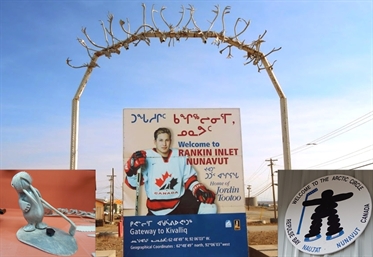Hockey fever up North
Hockey fever up North
Even in Canada’s Arctic, love for WJC and NHL is strong

 Rankin Inlet and Repulse Bay in Canada's far northern territory of Nunavut are well-established hockey hotbeds, home to NHLer and Team Canada member Jordin Tootoo. Photos: Lucas Aykroyd
Rankin Inlet and Repulse Bay in Canada's far northern territory of Nunavut are well-established hockey hotbeds, home to NHLer and Team Canada member Jordin Tootoo. Photos: Lucas Aykroyd
There’s a huge billboard featuring the first Inuit-born NHLer in his hometown of Rankin Inlet, Nunavut. Adorned with caribou antlers, it depicts the now-31-year-old veteran in the Team Canada sweater he wore at the 2003 IIHF World Junior Championship in Halifax, Nova Scotia.
When you spend time in the small, isolated communities in the Canadian North, you soon realize that passion for both IIHF tournaments and the NHL is just as deep-rooted up here as in major urban centres like Toronto or Montreal, which will co-host the World Juniors in 2015 and 2017.
In some ways, that passion is even stronger among the traditionally nomadic peoples of the North. There are so many other diversions and distractions in the cities. In Nunavut – Canada’s newest territory, created in 1999 – there are only 33,000 people in an area that’s eight times the size of Great Britain. Here, amid the endless waters of Hudson Bay and the stark, forbidding Arctic tundra, there is plenty of time to think about hockey.
When you’ve finished browsing through soapstone sculptures, bone carvings, and a children’s hockey book entitled Atausiraaallarumaluuunniit! at the Ivalu gift shop in Rankin Inlet, you come outside to the dirt road and a native man in a Hockey Canada T-shirt drives by on an ATV (all-terrain vehicle).
Walking toward the airport, you spot a towering inukshuk on a hill, which looks startlingly familiar. The inukshuk, a stone figure that looks human, was incorporated into the logo of one of the greatest sports events in Canadian history: the 2010 Vancouver Olympics, where the host nation’s men and women won double hockey gold.
In Repulse Bay, a hamlet of 1,045 inhabitants that’s right on the Arctic Circle, tourists come to observe polar bears, narwhal, bowhead whales, and other wildlife in an untamed environment, guided by operators like The Great Canadian Travel Company. But there’s also a well-used hockey arena, whose logo features a hockey stick-wielding inukshuk. It opens in November, when daily temperatures range between -10 and -21 Celsius.
“Hockey is very popular in Nunavut,” says Bill Kennedy, a long-haired, grey-bearded physical education teacher at Repulse Bay’s Tusarvik School, which offers classes from kindergarten to Grade 12. “Kids up North are much more physically active than in the South.” (The South, here, refers to southern Canada.)
Another Tootoo poster inside the school shows him flanked by four Inuit youths. The caption declares: “With hard work, dreams really can come true. Nunavummiut [natives] are succeeding – you can too.”
The former Brandon Wheat Kings star, who hovered near 200 PIM in each of his four major junior seasons, was dubbed the “Tootoo Train” during the World Juniors due to his intense physical style. He overcame great adversity to make it to Halifax – not just hailing from a remote area, but also surviving the tragic loss of his brother Terence, a fellow budding hockey who committed suicide at age 22.
Canada’s workmanlike 2003 roster, featuring other future NHLers like team scoring leader Carlo Coliacovo and starting goalie Marc-Andre Fleury, made it to the gold medal game. Despite battling heroically, Tootoo’s squad dropped a 3-2 decision to the Russians, led offensively by Igor Grigorenko, Yuri Trubachev, and a 17-year-old Alexander Ovechkin.
Yet settling for silver did nothing to dim Tootoo’s legend or hockey’s allure up here.
When you meet Repulse Bay mayor Solomon Malliki outside the Tusarvik School, for instance, he’s casually dressed with a Montreal Canadiens baseball cap.
And while touring in an open motorboat on Hudson Bay, guide Johnny Tagornak sports a Vancouver Canucks jacket. He talks about his favourite player being diminutive stickhandling whiz Cliff Ronning, and reminisces about a charity game that ex-NHLers like Dale Hawerchuk and Bob Bourne once played in Repulse Bay.
This conversation is startlingly juxtaposed with sights like a mother polar bear with two cubs swimming right past the boat, and bowhead whale skeletons lying on the beach.
Even artwork in the Canadian North melds traditional lore with hockey.
Churchill, Manitoba – Tootoo’s birthplace – is 950 kilometres southwest of Repulse Bay, and is dubbed the “Polar Bear Capital of the World.” Visit the Eskimo Museum there, and you may spot a small sculpture of a hockey-playing walrus. The 2004 piece by artist Billy Kuniliusie of Clyde River, Nunavut is mostly made of caribou antlers (the walrus’s whiskers, though, are toothbrush bristles).
Due to the expense and distance, Nunavut and northern Manitoba are often overlooked by visitors to Canada. Yet the passion for hockey up here can’t be ignored. Someday, there will be a successor to Jordin Tootoo.
And when the first puck is dropped at the 2015 IIHF World Junior Championship in Toronto and Montreal, the fans in the north will be glued to their TV sets and cheering on Team Canada just like their counterparts in Victoria, British Columbia or St. John’s, Newfoundland.
Back to Overview


















































